副词性从1(状语从句)
英语语法之副词从句(一)
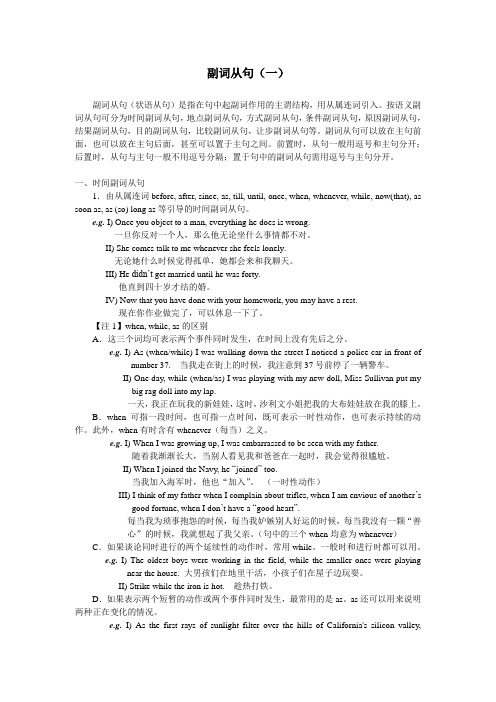
副词从句(一)副词从句(状语从句)是指在句中起副词作用的主谓结构,用从属连词引入。
按语义副词从句可分为时间副词从句,地点副词从句,方式副词从句,条件副词从句,原因副词从句,结果副词从句,目的副词从句,比较副词从句,让步副词从句等。
副词从句可以放在主句前面,也可以放在主句后面,甚至可以置于主句之间。
前置时,从句一般用逗号和主句分开;后置时,从句与主句一般不用逗号分隔;置于句中的副词从句需用逗号与主句分开。
一、时间副词从句1.由从属连词before, after, since, as, till, until, once, when, whenever, while, now(that), as soon as, as (so) long as等引导的时间副词从句。
e.g. I) Once you object to a man, everything he does is wrong.一旦你反对一个人,那么他无论坐什么事情都不对。
II) She comes talk to me whenever she feels lonely.无论她什么时候觉得孤单,她都会来和我聊天。
III) He didn’t get married until he was forty.他直到四十岁才结的婚。
IV) Now that you have done with your homework, you may have a rest.现在你作业做完了,可以休息一下了。
【注1】when, while, as的区别A.这三个词均可表示两个事件同时发生,在时间上没有先后之分。
e.g. I) As (when/while) I was walking down the street I noticed a police car in front ofnumber 37. 当我走在街上的时候,我注意到37号前停了一辆警车。
II) One day, while (when/as) I was playing with my new doll, Miss Sullivan put mybig rag doll into my lap.一天,我正在玩我的新娃娃,这时,沙利文小姐把我的大布娃娃放在我的膝上。
英语八大从句类型例句
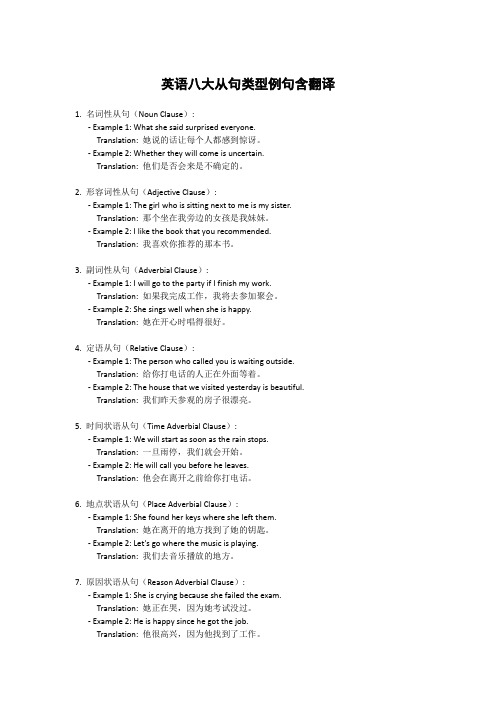
英语八大从句类型例句含翻译1. 名词性从句(Noun Clause):- Example 1: What she said surprised everyone.Translation: 她说的话让每个人都感到惊讶。
- Example 2: Whether they will come is uncertain.Translation: 他们是否会来是不确定的。
2. 形容词性从句(Adjective Clause):- Example 1: The girl who is sitting next to me is my sister.Translation: 那个坐在我旁边的女孩是我妹妹。
- Example 2: I like the book that you recommended.Translation: 我喜欢你推荐的那本书。
3. 副词性从句(Adverbial Clause):- Example 1: I will go to the party if I finish my work.Translation: 如果我完成工作,我将去参加聚会。
- Example 2: She sings well when she is happy.Translation: 她在开心时唱得很好。
4. 定语从句(Relative Clause):- Example 1: The person who called you is waiting outside.Translation: 给你打电话的人正在外面等着。
- Example 2: The house that we visited yesterday is beautiful.Translation: 我们昨天参观的房子很漂亮。
5. 时间状语从句(Time Adverbial Clause):- Example 1: We will start as soon as the rain stops.Translation: 一旦雨停,我们就会开始。
(完整)高中英语主要要掌握三大从句

高中英语主要要掌握三大从句。
分别是:1、定语从句(形容词从句)2、名词词从句(包括主语从句,宾语从句,表语从句,同位语从句)3、状语从句(副词性从句,包括时间,地点,结果,目的,原因等)一、定语从句:定语从句(Attributive Clauses)在句中做定语,修饰一个名词或代词,被修饰的名词,词组或代词即先行词。
定语从句通常出现在先行词之后,由关系词(关系代词或关系副词)引出。
1、关系代词引导的定语从句关系代词所代替的先行词是人或物的名词或代词,并在从句中充当主语、宾语、定语等成分。
关系代词在定语从句中作主词保持一致。
(1), who, whom, that这些词代替指人,“whom”作宾语指人,“that”既可作主语又可作宾语(作宾语可以省略),可以指人也可以指物。
(2),Which 用来指人或物(用作主语、宾语,作宾语时可以省略)(3),whose“whose”表示谁(可以为人也可以为物)的(东西)2、关系代词引导的定语从句(1),关系副词why主要用于修饰表示原因的名词(主要是the reason),同时它在定语从句中用作原因状语。
(2),关系副词when主要用于修饰表示时间的名词,同时它在定语从句中用作时间状语。
(3),关系副词where主要用于修饰表示地点的名词,同时它在定语从句中用作地点状语。
3、非限制性定语从句它起补充说明作用,缺少也不会影响全句的理解。
在非限制性定语从句的前面往往有逗号隔开。
二、名词性从句在句子中起名词作用的句子叫名词性从句(Noun Clauses)。
名词性从句的功能相当于名词词组, 它在复合句中能担任主语、宾语、表语、同位语、介词宾语等,因此根据它在句中不同的语法功能,名词性从句又可分别称为主语从句、宾语从句、表语从句和同位语从句。
引导名词性从句的连接词可分为三类:1、连词(5个):that (宾语从句或表语从句中that有时可以省略)whether,if (均表示“是否”表明从句内容的不确定性)as if ,as though (均表示“好像”,“似乎”)以上在从句中均不充当任何成分2、连接代词(9个):what, whatever, who, whoever, whom, whomever, whose, which, whichever3、连接副词(7个):when, where, how, why, whenever, wherever, however三、状语从句状语从句(Adverbial Clause)状语从句指句子用作状语时,起副词作用的句子。
副词性从句作状语和宾语补足语
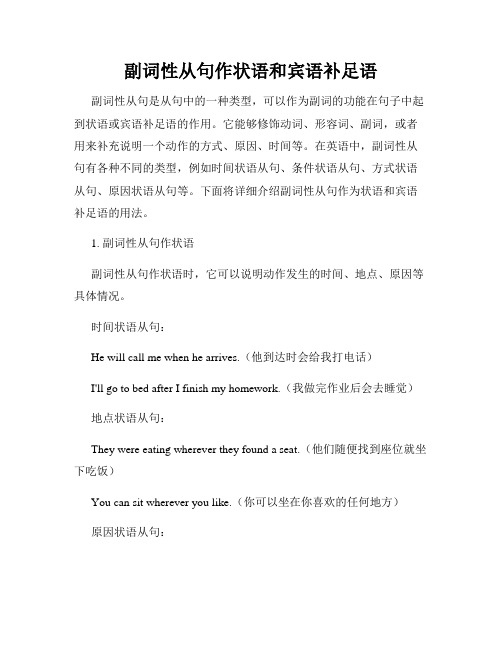
副词性从句作状语和宾语补足语副词性从句是从句中的一种类型,可以作为副词的功能在句子中起到状语或宾语补足语的作用。
它能够修饰动词、形容词、副词,或者用来补充说明一个动作的方式、原因、时间等。
在英语中,副词性从句有各种不同的类型,例如时间状语从句、条件状语从句、方式状语从句、原因状语从句等。
下面将详细介绍副词性从句作为状语和宾语补足语的用法。
1. 副词性从句作状语副词性从句作状语时,它可以说明动作发生的时间、地点、原因等具体情况。
时间状语从句:He will call me when he arrives.(他到达时会给我打电话)I'll go to bed after I finish my homework.(我做完作业后会去睡觉)地点状语从句:They were eating wherever they found a seat.(他们随便找到座位就坐下吃饭)You can sit wherever you like.(你可以坐在你喜欢的任何地方)原因状语从句:They went home because it was raining heavily.(因为下大雨,他们回家了)She smiled as she saw her friend.(她看见朋友时笑了)方式状语从句:He learns English as if he were a native speaker.(他学英语的方式像是一个母语者)She opened the door as though nothing had happened.(她打开门好像什么都没发生过)条件状语从句:If it rains tomorrow, we will stay at home.(如果明天下雨,我们会呆在家里)I'll lend you the money provided that you pay me back next week.(只要你下周还我钱,我就借给你)2. 副词性从句作宾语补足语副词性从句还可以作为宾语补足语,对于某些表示思考、感觉、告知、建议等的动词起到补充说明的作用。
英语从句类型及判别方法
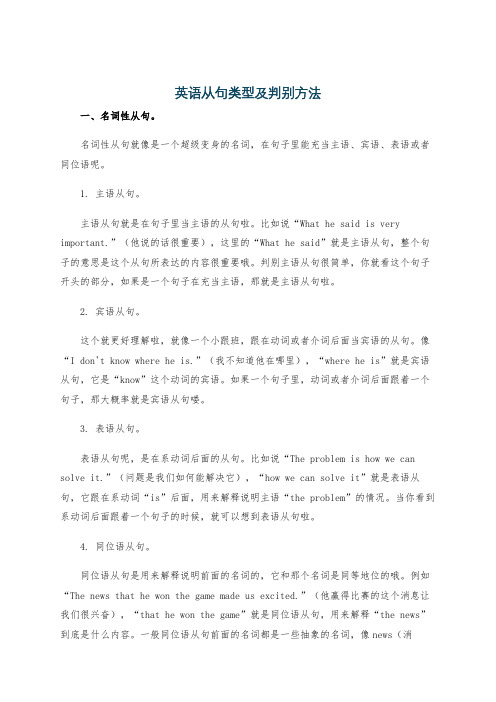
英语从句类型及判别方法一、名词性从句。
名词性从句就像是一个超级变身的名词,在句子里能充当主语、宾语、表语或者同位语呢。
1. 主语从句。
主语从句就是在句子里当主语的从句啦。
比如说“What he said is very important.”(他说的话很重要),这里的“What he said”就是主语从句,整个句子的意思是这个从句所表达的内容很重要哦。
判别主语从句很简单,你就看这个句子开头的部分,如果是一个句子在充当主语,那就是主语从句啦。
2. 宾语从句。
这个就更好理解啦,就像一个小跟班,跟在动词或者介词后面当宾语的从句。
像“I don't know where he is.”(我不知道他在哪里),“where he is”就是宾语从句,它是“know”这个动词的宾语。
如果一个句子里,动词或者介词后面跟着一个句子,那大概率就是宾语从句喽。
3. 表语从句。
表语从句呢,是在系动词后面的从句。
比如说“The problem is how we can solve it.”(问题是我们如何能解决它),“how we can solve it”就是表语从句,它跟在系动词“is”后面,用来解释说明主语“the problem”的情况。
当你看到系动词后面跟着一个句子的时候,就可以想到表语从句啦。
4. 同位语从句。
同位语从句是用来解释说明前面的名词的,它和那个名词是同等地位的哦。
例如“The news that he won the game made us excited.”(他赢得比赛的这个消息让我们很兴奋),“that he won the game”就是同位语从句,用来解释“the news”到底是什么内容。
一般同位语从句前面的名词都是一些抽象的名词,像news(消息)、idea(想法)之类的,后面跟着一个句子来详细解释这个名词,那就是同位语从句啦。
二、形容词性从句(定语从句)定语从句就像是一个小尾巴,用来修饰名词或者代词的。
副词从句和状语从句的区别与运用
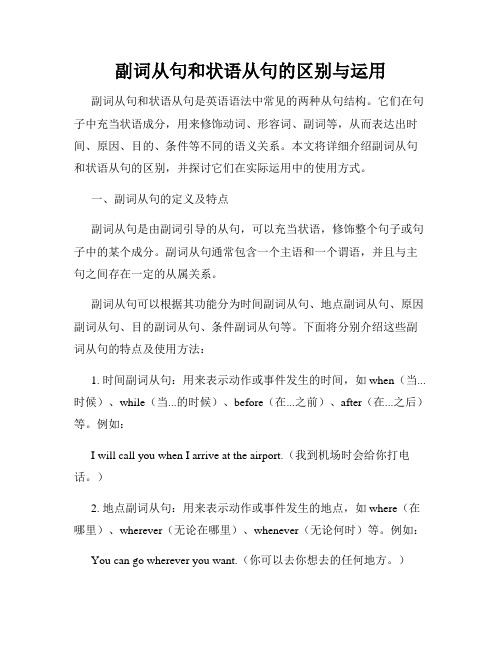
副词从句和状语从句的区别与运用副词从句和状语从句是英语语法中常见的两种从句结构。
它们在句子中充当状语成分,用来修饰动词、形容词、副词等,从而表达出时间、原因、目的、条件等不同的语义关系。
本文将详细介绍副词从句和状语从句的区别,并探讨它们在实际运用中的使用方式。
一、副词从句的定义及特点副词从句是由副词引导的从句,可以充当状语,修饰整个句子或句子中的某个成分。
副词从句通常包含一个主语和一个谓语,并且与主句之间存在一定的从属关系。
副词从句可以根据其功能分为时间副词从句、地点副词从句、原因副词从句、目的副词从句、条件副词从句等。
下面将分别介绍这些副词从句的特点及使用方法:1. 时间副词从句:用来表示动作或事件发生的时间,如when(当...时候)、while(当...的时候)、before(在...之前)、after(在...之后)等。
例如:I will call you when I arrive at the airport.(我到机场时会给你打电话。
)2. 地点副词从句:用来表示动作或事件发生的地点,如where(在哪里)、wherever(无论在哪里)、whenever(无论何时)等。
例如:You can go wherever you want.(你可以去你想去的任何地方。
)3. 原因副词从句:用来表示某种原因或理由,如because(因为)、since(既然)、as(由于)等。
例如:He couldn't come to the party because he was sick.(他因为生病不能参加派对。
)4. 目的副词从句:用来表示动作或意图的目的,如so that(以便)、in order that(为了)等。
例如:I brought my umbrella so that I won't get wet in the rain.(我带了伞,以便在雨中不被淋湿。
)5. 条件副词从句:用来表示某一条件下会发生的情况,如if(如果)、unless(除非)、as long as(只要)等。
副词性从句(状语从句)的译法1.1

三、副词性从句(状语从句)的译法英语中状语从句体现了从句和主句之间的逻辑关系,它具体可以分为9种:时间、地点、条件、让步、原因、结果、目的、比较和方式状语。
其中,状语从句的翻译方法,总的来说遵循三点主要原则:①连词能省则省,只要能把意思说清楚,尽量不使用连词。
②如果条件或让步状语从句在整句中语气较弱,可以把主句译在前面,从句译在后面。
③状语从句的位置可以灵活变动,以便使译文更流畅。
④种类的判断主要依赖于连词语义的判断。
下面,我们就通过几个例子分析一下状语从句在考试中出现的形式。
1. While formal learning is transmitted by teachers selected to perform this role, informal learning is acquired as a natural part of a child's development。
本句中包含一个While引导的让步状语从句,第二部分是主句;从句中,formal learning是主语,谓语是is transmitted,过去分词selected作teachers的后置定语,是不定式to perform this role作selected的目的状语;主句中,informal learning是主语,谓语是is acquired,介词短语as a natural part of a child's development作acquired的结果状语。
参考译文:尽管正式的学习过程是由挑选出来担当此角色的教师来进行的,非正式的学习过程却是作为孩子成长的自然一部分而完成的。
2. While it is true that this competition may induce efforts to expand territory at the expense of others, and thus lead to conflict, it cannot be said that war-like conflict among other nations is inevitable, although competition is。
状语从句是副词性从句
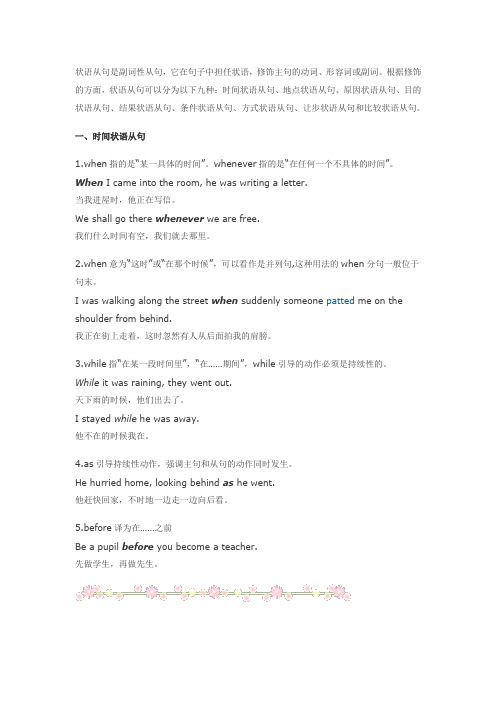
状语从句是副词性从句,它在句子中担任状语,修饰主句的动词、形容词或副词。
根据修饰的方面,状语从句可以分为以下九种:时间状语从句、地点状语从句、原因状语从句、目的状语从句、结果状语从句、条件状语从句、方式状语从句、让步状语从句和比较状语从句。
一、时间状语从句1.when指的是“某一具体的时间”。
whenever指的是“在任何一个不具体的时间”。
When I came into the room, he was writing a letter.当我进屋时,他正在写信。
We shall go there whenever we are free.我们什么时间有空,我们就去那里。
2.when意为“这时”或“在那个时候”,可以看作是并列句,这种用法的when分句一般位于句末。
I was walking along the street when suddenly someone patted me on the shoulder from behind.我正在街上走着,这时忽然有人从后面拍我的肩膀。
3.while指“在某一段时间里”,“在……期间”,while引导的动作必须是持续性的。
While it was raining, they went out.天下雨的时候,他们出去了。
I stayed while he was away.他不在的时候我在。
4.as引导持续性动作,强调主句和从句的动作同时发生。
He hurried home, looking behind as he went.他赶快回家,不时地一边走一边向后看。
5.before译为在……之前Be a pupil before you become a teacher.先做学生,再做先生。
6.after译为在……之后He arrived after the game started.比赛开始后,他到了。
7.如主句动词是持续性动作,常用肯定式,表示“直到……为止”。
初三英语语法串讲从句的分类与用法
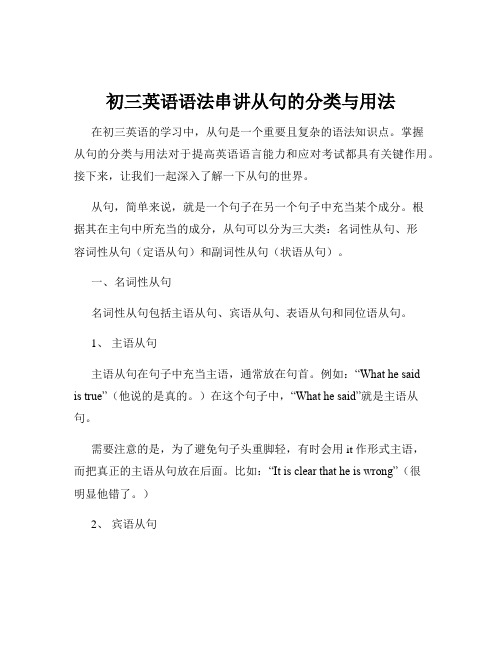
初三英语语法串讲从句的分类与用法在初三英语的学习中,从句是一个重要且复杂的语法知识点。
掌握从句的分类与用法对于提高英语语言能力和应对考试都具有关键作用。
接下来,让我们一起深入了解一下从句的世界。
从句,简单来说,就是一个句子在另一个句子中充当某个成分。
根据其在主句中所充当的成分,从句可以分为三大类:名词性从句、形容词性从句(定语从句)和副词性从句(状语从句)。
一、名词性从句名词性从句包括主语从句、宾语从句、表语从句和同位语从句。
1、主语从句主语从句在句子中充当主语,通常放在句首。
例如:“What he saidis true”(他说的是真的。
)在这个句子中,“What he said”就是主语从句。
需要注意的是,为了避免句子头重脚轻,有时会用 it 作形式主语,而把真正的主语从句放在后面。
比如:“It is clear that he is wrong”(很明显他错了。
)2、宾语从句宾语从句在句子中充当宾语,常跟在及物动词、介词或某些形容词后面。
例如:“I believe that he is honest”(我相信他是诚实的。
)“We are interested in what you said”(我们对你所说的感兴趣。
)宾语从句的语序要用陈述句语序,即“主语+谓语+其他”。
同时,要注意宾语从句的时态,要根据主句的时态来变化。
3、表语从句表语从句在句子中充当表语,位于系动词之后。
例如:“The problem is whether we can finish the work on time”(问题是我们能否按时完成工作。
)4、同位语从句同位语从句用于解释说明前面的名词的具体内容。
常见的名词有:fact, news, idea, thought, hope 等。
例如:“The news that he will come is true”(他要来的消息是真的。
)二、形容词性从句(定语从句)定语从句在句中起定语作用,修饰一个名词或代词。
副词性从句
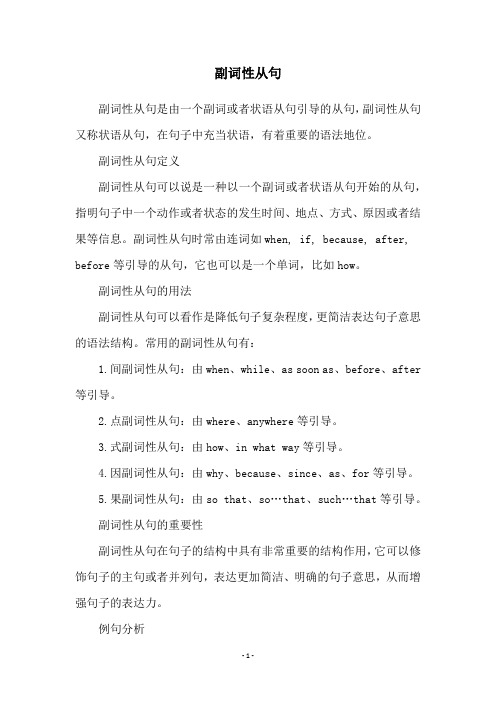
副词性从句副词性从句是由一个副词或者状语从句引导的从句,副词性从句又称状语从句,在句子中充当状语,有着重要的语法地位。
副词性从句定义副词性从句可以说是一种以一个副词或者状语从句开始的从句,指明句子中一个动作或者状态的发生时间、地点、方式、原因或者结果等信息。
副词性从句时常由连词如when, if, because, after, before等引导的从句,它也可以是一个单词,比如how。
副词性从句的用法副词性从句可以看作是降低句子复杂程度,更简洁表达句子意思的语法结构。
常用的副词性从句有:1.间副词性从句:由when、while、as soon as、before、after 等引导。
2.点副词性从句:由where、anywhere等引导。
3.式副词性从句:由how、in what way等引导。
4.因副词性从句:由why、because、since、as、for等引导。
5.果副词性从句:由so that、so…that、such…that等引导。
副词性从句的重要性副词性从句在句子的结构中具有非常重要的结构作用,它可以修饰句子的主句或者并列句,表达更加简洁、明确的句子意思,从而增强句子的表达力。
例句分析1.We can learn English well when we love it.这个句子中的副词性从句when we love it修饰了主句We can learn English well,表达了当我们热爱英语时才能学好英语的意思,这里的when引导的时间副词性从句,起到了修饰主句的重要作用。
2.She sings beautifully, which can make people happy.这个句子中的副词性从句which can make people happy用来修饰句子的主句She sings beautifully,表达了她唱歌美妙,可以让人感到高兴。
这里的which引导的结果副词性从句,起到了表达句意的重要作用。
副词性从句状语从句

第三章状语从句状语从句种类多,但是含义易掌握时间地点及原因,目的条件和结果比较让步及方式,功能专一作状语。
状语从句学什么?首当其冲是连词引导连词怎么用?依据词义行得通。
特殊句型须牢记,考点往往于其中。
学习状语从句,首先有必要弄清以下几个概念或术语:1、什么是状语从句?在复合句中,修饰主句中的动词、形容词、副词等的从句就叫作状语从句。
由于状语从句起的是副词作用,因此,这种从句也可以称为副词性从句。
英语中的状语从句常见的有九种:时间状语从句、地点状语从句、原因状语从句、目的状语从句、条件状语从句、比较状语从句、让步状语从句、结果状语从句、方式状语从句。
在复合句中作时间状语的从句就叫时间状语从句,其他类推。
状语的从句的位置比较灵活,可以放在句首(主句之前),也可以放在句尾(主句之后)。
2、状语从句用什么样的词引导?不管是哪一种状语从句,都需要有一个词引导,这种引导词叫作连词,也可以叫作连接词或从属连词或关联词,我们称为连词。
引导状语从句的连词语较多,按照它们表示的含义可以分为九类:时间、地点、原因、目的、条件、比较、让步、结果、方式状语从句。
虽然不需要记住都有哪些连词可以引导状语从句,但是必须知道每个连词的词义,因为状语从句考查连词时,都是根据连词本身的词义来决定。
引导状语从句的连词不能省略。
、第一招:学会引导各种状语从句的连词的基本用法以及下面几组连词的比较:1、when\while\as2、till/until3、 immediately/directly/instantly/the moment(that)/the minute(that)/theinstant(that)/as soon as/hardly….when/no sooner….than/scarcely…..when/before.4、once…./as soon as5、as/because/since/for6、 since/when7、unless/if ..,..not8、as long as/so long as9、as far as/so far as10、although/though/as/while11、even though/even if 12、no matter what../whatever13、so…that/such….that14、so;….that/so that状语从句主要考查连词的选择。
英语中五大从句
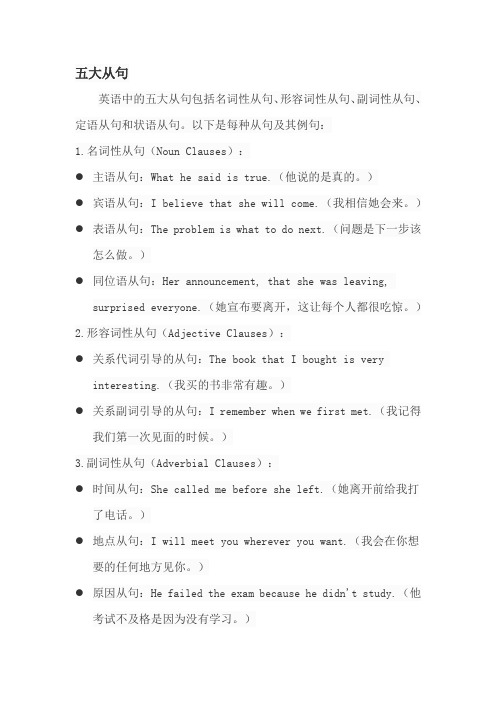
五大从句英语中的五大从句包括名词性从句、形容词性从句、副词性从句、定语从句和状语从句。
以下是每种从句及其例句:1.名词性从句(Noun Clauses):●主语从句:What he said is true.(他说的是真的。
)●宾语从句:I believe that she will come.(我相信她会来。
)●表语从句:The problem is what to do next.(问题是下一步该怎么做。
)●同位语从句:Her announcement, that she was leaving,surprised everyone.(她宣布要离开,这让每个人都很吃惊。
)2.形容词性从句(Adjective Clauses):●关系代词引导的从句:The book that I bought is veryinteresting.(我买的书非常有趣。
)●关系副词引导的从句:I remember when we first met.(我记得我们第一次见面的时候。
)3.副词性从句(Adverbial Clauses):●时间从句:She called me before she left.(她离开前给我打了电话。
)●地点从句:I will meet you wherever you want.(我会在你想要的任何地方见你。
)●原因从句:He failed the exam because he didn't study.(他考试不及格是因为没有学习。
)●条件从句:If it rains, we will stay indoors.(如果下雨,我们将呆在室内。
)●结果从句:He worked hard, so he succeeded.(他努力工作,所以成功了。
)4.定语从句(Adjective Clauses):●关系代词引导的从句:The man who is talking to my mother ismy uncle.(正在和我妈妈交谈的那个人是我叔叔。
英语3大从句
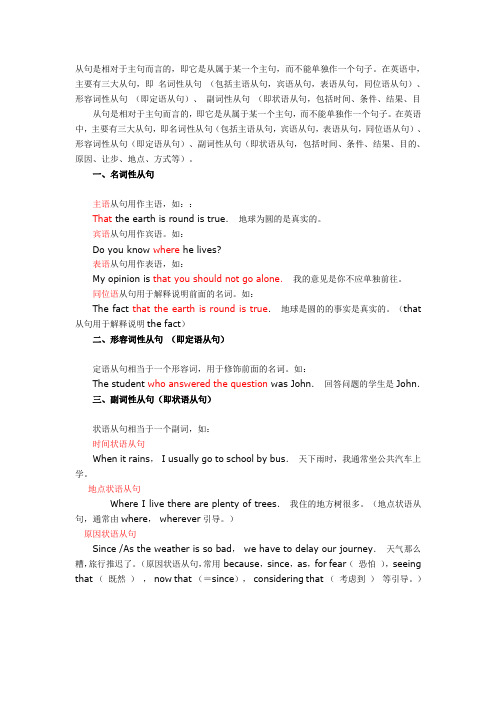
从句是相对于主句而言的,即它是从属于某一个主句,而不能单独作一个句子。
在英语中,主要有三大从句,即名词性从句(包括主语从句,宾语从句,表语从句,同位语从句)、形容词性从句(即定语从句)、副词性从句(即状语从句,包括时间、条件、结果、目从句是相对于主句而言的,即它是从属于某一个主句,而不能单独作一个句子。
在英语中,主要有三大从句,即名词性从句(包括主语从句,宾语从句,表语从句,同位语从句)、形容词性从句(即定语从句)、副词性从句(即状语从句,包括时间、条件、结果、目的、原因、让步、地点、方式等)。
一、名词性从句主语从句用作主语,如::That the earth is round is true.地球为圆的是真实的。
宾语从句用作宾语。
如:Do you know where he lives?表语从句用作表语,如:My opinion is that you should not go alone.我的意见是你不应单独前往。
同位语从句用于解释说明前面的名词。
如:The fact that the earth is round is true.地球是圆的的事实是真实的。
(that 从句用于解释说明the fact)二、形容词性从句(即定语从句)定语从句相当于一个形容词,用于修饰前面的名词。
如:The student who answered the question was John.回答问题的学生是John.三、副词性从句(即状语从句)状语从句相当于一个副词,如:时间状语从句When it rains, I usually go to school by bus.天下雨时,我通常坐公共汽车上学。
地点状语从句Where I live there are plenty of trees.我住的地方树很多。
(地点状语从句,通常由where, wherever引导。
)原因状语从句Since /As the weather is so bad, we have to delay our journey.天气那么糟,旅行推迟了。
副词性从句状语从句
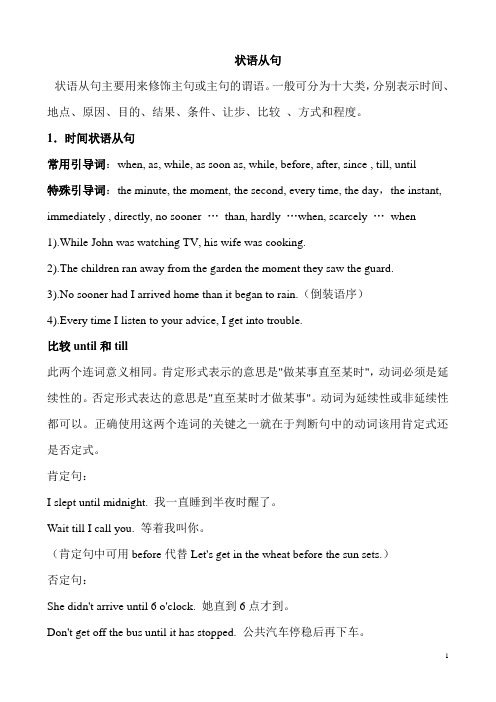
状语从句状语从句主要用来修饰主句或主句的谓语。
一般可分为十大类,分别表示时间、地点、原因、目的、结果、条件、让步、比较、方式和程度。
1.时间状语从句常用引导词:when, as, while, as soon as, while, before, after, since , till, until特殊引导词:the minute, the moment, the second, every time, the day,the instant, immediately , directly, no sooner …than, hardly …when, scarcely …when1).While John was watching TV, his wife was cooking.2).The children ran away from the garden the moment they saw the guard.3).No sooner had I arrived home than it began to rain.(倒装语序)4).Every time I listen to your advice, I get into trouble.比较until和till此两个连词意义相同。
肯定形式表示的意思是"做某事直至某时",动词必须是延续性的。
否定形式表达的意思是"直至某时才做某事"。
动词为延续性或非延续性都可以。
正确使用这两个连词的关键之一就在于判断句中的动词该用肯定式还是否定式。
肯定句:I slept until midnight. 我一直睡到半夜时醒了。
Wait till I call you. 等着我叫你。
(肯定句中可用before代替Let's get in the wheat before the sun sets.)否定句:She didn't arrive until 6 o'clock. 她直到6点才到。
英语八大从句类型总结

英语八大从句类型总结总结:从句是构成复合句的一部分,也是英语语法中非常重要的部分。
根据从句的用途和功能,可以将从句分为八大类型,分别是名词性从句、形容词性从句、副词性从句、定语从句、宾语从句、主语从句、表语从句和同位语从句。
每种从句都具有自己的特点和用法,下面将逐一介绍。
1. 名词性从句(Noun Clauses):名词性从句可作主语、宾语、表语和同位语等。
其引导词有that, whether, if, what, who, whom, which, whoever, whatever, whenever, wherever等。
名词性从句在句子中起到名词的作用,可代替一个名词短语或单个名词。
例句:- I don't know what he is doing.(主语从句)- Can you tell me where the library is?(宾语从句)- His question is whether we can finish the project on time.(表语从句)2. 形容词性从句(Adjective Clauses):形容词性从句用来修饰名词或代词,通常位于其所修饰的名词或代词之后。
其引导词有that, who, whom, which等。
例句:- The book that you lent me is very interesting.(修饰名词book)- I know a girl who can play the piano very well.(修饰名词girl)3. 副词性从句(Adverb Clauses):副词性从句用来修饰动词、形容词或副词,通常位于句子中的谓语动词之后。
根据从句的用途和功能,副词性从句可以分为条件状语从句、时间状语从句、地点状语从句、方式状语从句、目的状语从句、结果状语从句和比较状语从句等。
例句:- If it rains tomorrow, we won't go to the park.(条件状语从句)- He has lived in New York since he moved there ten years ago.(时间状语从句)- She looked for her keys everywhere she could think of.(地点状语从句)4. 定语从句(Relative Clauses):定语从句用来修饰名词或代词,通常位于其所修饰的名词或代词之后。
复合句—副词性从句——状语从句
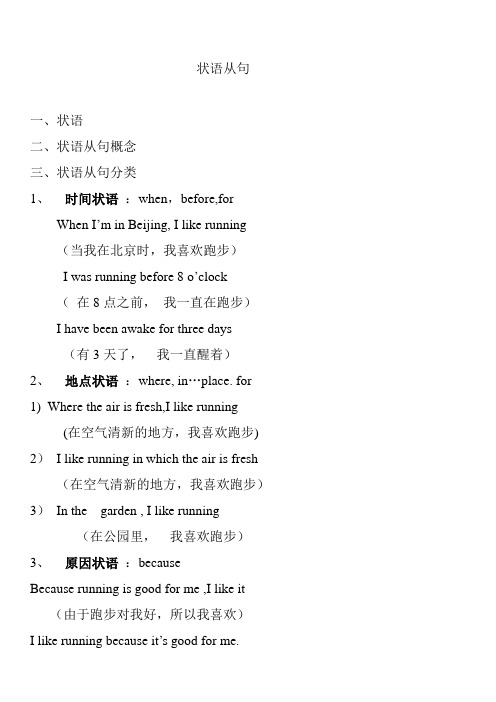
状语从句一、状语二、状语从句概念三、状语从句分类1、时间状语:when,before,forWhen I’m in Beijing, I like running(当我在北京时,我喜欢跑步)I was running before 8 o’clock(在8点之前,我一直在跑步)I have been awake for three days(有3天了,我一直醒着)2、地点状语:where, in…place. for 1)Where the air is fresh,I like running(在空气清新的地方,我喜欢跑步) 2)I like running in which the air is fresh (在空气清新的地方,我喜欢跑步)3)In the garden , I like running(在公园里,我喜欢跑步)3、原因状语:becauseBecause running is good for me ,I like it (由于跑步对我好,所以我喜欢)I like running because it’s good for me.(由于跑步对我好,所以我喜欢)4、目的状语:in order toIn order to be healthy ,I like running(为了健康,我喜欢奔跑)I like running in order to be healthy(为了健康,我喜欢奔跑)5、伴随状语:with n / doing, doing1) With the wind blowing ,I’m running(随着风在吹动,我在奔跑)2)I’m running with the wind blowing(随着风在吹动,我在奔跑)3)I’m running , seeing the bird .(看着鸟,我在奔跑)4)Seeing the bird, I’m running(看着鸟,我在奔跑)5)With the exception of singing,I also like running.(除了唱歌,我还喜欢奔跑)配题:Late in the afternoon a young man came along .He saw the stone , _saying ___(say )to himself .“The night will be very dark .Some neighbors will come along later in the dark and will fall against the stone .” --3)6、方式状语:by,throughI’m running ,by moving my legs.(通过摆动我的腿,我正在奔跑)7、条件状语:if,forIf the air is fresh, I will run(如果空气清新,我将会奔跑)For the English teaching, I’m OK.(对于英语教学,我是可以的)8 比较状语:thanI run farther than you(比起你,我跑得更快)I have less impact on the society than celebrities= I have less impact on the society than the impact of celebrities on the society (比起名人对于社会的影响力,我对于社会的影响力更小)9、让步状语: no matterNo matter how hard it is ,I will run.(无论多么艰难,我都要奔跑)10、结果状语:so that ,only to doI run so fast that I’m very tired(我跑得太快了以致使我非常疲惫)配题2014天津5. Anxiously, she took the dress out of the package and tried it on, only _to find _____ it didn’t fitA. to findB. foundC. findingD. having found。
三大从句的区分

三大从句的区分首先三大从句是形容词性从句(即定语从句);副词性从句(即状语从句);和名词性从句(包括:主语从句,宾语从句,表语从句和同位语从句)修饰名词或代词的从句是定语从句He who does not reach the Great Wall is not a true man.We are all looking forward to the day when 2008 Olympic Games begin in Beijing.修饰一个句子的从句是状语从句When he was walking in the street yesterday, he met with a friend of his.在句中作主语的从句叫主语从句,That he came home late at night worried his parents.在句中作宾语的从句叫宾语从句,I don't know why he came home late at night.在句中作表语的从句叫表语从句,It looks as if it is going to rain.在句中作同位语的从句叫同位语从句I have no idea why he came home late at night.定义及相关术语1.定语从句:修饰某一名词或代词的从句叫定语从句。
定语从句一般紧跟在它所修饰的先行词之后。
2.先行词:被定语从句修饰的词叫先行词。
3.关系词:引导定语从句的词叫关系词。
关系词有关系代词和关系副词。
关系代词有that, which, who, whom, whose, as等;关系副词有when, where, why等。
关系词通常有下列三个作用:A、引导定语从句;B、代替先行词;C、在定语从句中担当一个成分。
例如:The man who is shaking hands with my father is a policeman. 该句中,who is shaking hands with my father 是定语从句,修饰先行词the man,“who”是引导定语从句的关系词,代替先行词the man,在定语从句中作主语。
副词性(状语)从句
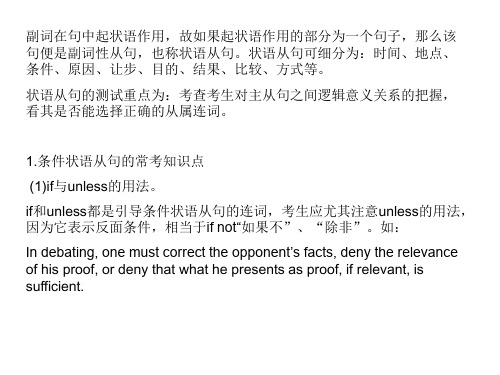
状语从句的测试重点为:考查考生对主从句之间逻辑意义关系的把握, 看其是否能选择正确的从属连词。
1.条件状语从句的常考知识点
(1)if与unless的用法。
2.让步状语从句的常考知识点
(1)as 引导让步从句,要求用倒装结构,把强调的部分置于句首。如: Much as he likes her, he does get irritated with her sometimes. Humble as it may be, there is no place like home.
(4)名词短语、介词短语each /every time, the moment/second/minute, in the time, by the time起连词作用。 如:I hope her health will have improved greatly by the time we come back next year. My pain must have been apparent the moment I walked into the room, for the first man I met asked sympathetically: “Are you feeling all right?” Mercury’s velocity is so much greater than the Earth’s that it completes more than four revolutions around the Sun in the time it takes the Earth to complete one.
初中英语语法讲解--名词性从句、形容词性从句、副词性从句三大从句讲解

初中英语语法讲解:名词性从句、形容词性从句、副词性从句一、名词性从句1. 概念名词性从句是指在句子中起名词作用的从句,包括主语从句、宾语从句、表语从句和同位语从句。
2. 搭配与用法主语从句:作为句子的主语,通常使用连接词that(无实际意义,不可省略)或whether/if(表示选择,不可省略)引导。
例句:That he will come to the party remains uncertain.(他是否会来参加聚会还不确定。
)宾语从句:作为动词或介词的宾语,可以由that、if/whether、特殊疑问词等引导。
例句:I don't know if he will come.(我不知道他是否会来。
)表语从句:作为连系动词的表语,通常由that引导,但that通常可以省略。
例句:The fact is that he didn't come.(事实是,他没来。
)同位语从句:用于解释说明前面的名词,通常由that引导,但that不可省略。
例句:The news that he resigned was a surprise.(他辞职的消息是个惊喜。
)3. 注意事项宾语从句中,当主句的谓语动词是think、believe、expect、suppose等表示心理活动的动词时,如果宾语从句表示的是事实,则宾语从句的否定通常要转移到主句上来表达。
例句:I don't think he will come.(我认为他不会来。
)在名词性从句中,一般不使用疑问句语序,而是使用陈述句语序。
例句:Can you tell me how I can get to the park?(请告诉我如何去公园?)而不是Can you tell me how can I get to the park?二、形容词性从句(定语从句)1. 概念形容词性从句,也称为定语从句,用于修饰或限定一个名词或代词,描述这个名词或代词的性质或特征。
英语语法 什么是副词性从句
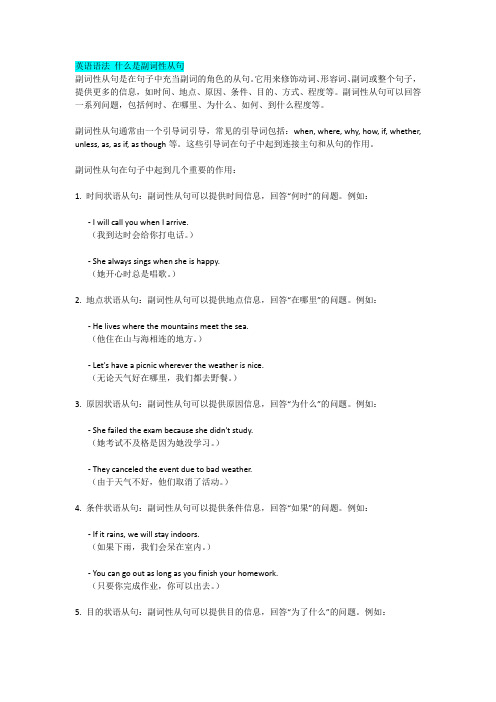
英语语法什么是副词性从句副词性从句是在句子中充当副词的角色的从句。
它用来修饰动词、形容词、副词或整个句子,提供更多的信息,如时间、地点、原因、条件、目的、方式、程度等。
副词性从句可以回答一系列问题,包括何时、在哪里、为什么、如何、到什么程度等。
副词性从句通常由一个引导词引导,常见的引导词包括:when, where, why, how, if, whether, unless, as, as if, as though等。
这些引导词在句子中起到连接主句和从句的作用。
副词性从句在句子中起到几个重要的作用:1. 时间状语从句:副词性从句可以提供时间信息,回答“何时”的问题。
例如:- I will call you when I arrive.(我到达时会给你打电话。
)- She always sings when she is happy.(她开心时总是唱歌。
)2. 地点状语从句:副词性从句可以提供地点信息,回答“在哪里”的问题。
例如:- He lives where the mountains meet the sea.(他住在山与海相连的地方。
)- Let's have a picnic wherever the weather is nice.(无论天气好在哪里,我们都去野餐。
)3. 原因状语从句:副词性从句可以提供原因信息,回答“为什么”的问题。
例如:- She failed the exam because she didn't study.(她考试不及格是因为她没学习。
)- They canceled the event due to bad weather.(由于天气不好,他们取消了活动。
)4. 条件状语从句:副词性从句可以提供条件信息,回答“如果”的问题。
例如:- If it rains, we will stay indoors.(如果下雨,我们会呆在室内。
)- You can go out as long as you finish your homework.(只要你完成作业,你可以出去。
- 1、下载文档前请自行甄别文档内容的完整性,平台不提供额外的编辑、内容补充、找答案等附加服务。
- 2、"仅部分预览"的文档,不可在线预览部分如存在完整性等问题,可反馈申请退款(可完整预览的文档不适用该条件!)。
- 3、如文档侵犯您的权益,请联系客服反馈,我们会尽快为您处理(人工客服工作时间:9:00-18:30)。
副词性从句(状语从句)状语从句在复合句中做状语可修饰主句中的动词、形容词、和副词等。
状语从句有从属连词引导,与主句相接。
状语从句的位置可放在句首或句末。
放在句首时,其后常用逗号,放在句末时,其前一般不用逗号。
状语从句根据它们的含义一般可分为十大类,分别表示时间、地点、原因、目的、结果、条件、让步、比较、方式和程度状语从句。
一、时间状语从句常用的连词有:before, after, when, as(当,一边…一边), while(在…期间), whenever (无论何时,每当),since(自从…以来),as soon as/hardly …when/no sooner than (一…就…),till /until。
如果主句是一般将来时,状语从句中用一般现在时。
since所引导的从句一般要用非延续性动词,主句用完成时态。
1. while, when, whenever和as的用法比较(1) while常表示一段较长的时间或一个过程,强调主句的动词和从句的动词所表示的动作或状态是同时发生的。
她不能表示一时性或暂时性的动作。
Don’t talk so loud while others are working.While he was eating, I asked him to lend me 2 dollars(2) when 引导的时间状语从句可以指时间的一点,也可以指一段时间,从句的谓语动词可用终止性动词,也可用延续性动词.when引导的从句表示具体的时间,从句的动作和主句的动作可以同时也可以先于主句的动作.whenever指任何一个不具体的时间. It was raining when we arrived.(动作同时,指时间点) When you read the poem a second time, the meaning will become clearer to you. (动作有先后,指时间点,不能用while) (3) as用as时主句和从句的动作往往同时发生,具有延伸意义,一般同延续性动词连用,有时可译作“一边…一边”As time went on, his theory proved to be correct.As we walked, we talked.2. since 和before 的用法比较两者均可用于“ It be… since/before+从句”的句型.区别在于since 表示“自从…以来”,所在主从句的谓语动词的时态关系是:It is /has been sometime since sb. did sth.而before的含义是“(过了多久)才…”主从句的谓语动词的时态关系是: It was /had been sometime before sb. did sth. 表过去和将来时,两者相应的句型分别是: It was some time since sb had done sth.和It will be some time before sb does sth.It is 30 years since he joined the revolution.It was three days before he came back.二地点状语从句常用的从属连词有:where, wherever(无论哪里), everywhere(在每一个地方).After the war, a new school building was put up where there has once been a theatre.She found her calculator where she lost it .Everywhere they went ,the distinguished guests were warmly welcomed.Sit wherever you like.三原因状语从句原因状语从句一般由because(因为),since(既然),as(由于),now that(既然,因为)等连词引导.1. because ,since ,as 和now that(1) becauseBecause 表示直接的原因或理由,表示原因的语气最强,常表示必然的因果关系.回答以引起的特殊疑问句,只能用because.Jane wore a raincoat because it was raining.He is absent today because he is ill(2) sincesince表示对方已经知晓,无须加以说明的原因和事实,语气比because 稍弱.I’ll do it for you since you are busy.Since you have seen both fighters, who do you think will win?(3)asas表示的往往是十分明显的原因,听者或读者已经知道或能看得出来,语气较弱,只起附带说明,比较口语化.We had better hurry as it’s getting dark.As you object, I’ll change the plan.(4) forfor是并列连词,引导的分句不表示直接的原因,而是用来附带解释和说明前面一句的情况.for 引导的分句常位于第一分句,之间用逗号隔开.It must have rained last night, for the ground is wet this morning.The day breaks, for the birds are singing.(5) now thatNow that意为“既然”,与since 同义,但更突出事实本身。
Now that you’ve got a chance, you m ight as well make full use of it.Now that everyone is here, let’s begin our meeting.四、目的状语从句目的状语从句由that, so that, in order that等引导。
从句中的谓语动词前常有情态动词may, might, can, could, will, would等。
John shut everybody out of the kitchen so that he could prepare his grand surprise for the party.These men risk their lives in order that we may live more safely.辨析:in order that 引导的状语从句可以放在句首与句尾,而so that引导的只能放在句尾。
如果从句主语与主句主语一致,都可以转换成不定式。
She went downtown so that /in order that she would buy some clothes. =She went downtown so as to /in order to buy some clothes.In order that he could make himself understood, he explained it again. =In order to make himself understood, he explained it again.五、结果状语从句1. so that, so …that, such that引导结果状语从句He worked hard so that he passed the exam.The film was so wonderful that we wanted to see it again.He spoke for such a long time that people began to fall asleep.2. so…that与such…that 的区别这两种结构都可以引导结果状语从句. so是副词,后接形容词或副词;such 是形容词,后接名词。
(1)单数名词在so that和such that 中间出现的是单数名词,且该名词前有形容词修饰时,这两种结构可互换,但要注意它们的词序不同:such+a/an+形容词+名词= so+形容词+a/an+名词。
She is such a good teacher that all of us love her.=She is so good a teacher that all of us love her. (2)不可数名词或复数可数名词如果被修饰的是不可数名词或复数可数名词时,一般须用such thatHe made such rapid progress that before long he gegan to write articles in English.They are such interesting books that we all want to read them.(3)名词前有many, such, little, few修饰时如果不可数名词或复数可数名词前有many, such, little, few修饰时,则用so… thatI’ve so many falls that I’m black and blue all over.George had so little money that he had to get a job.They are so little children that they can’t do anything.3. 如何判断so ..that 引导的目的状语从句与结果状语从句(1)当表达的含义是“为了”,“以便”时,为目的状语从句;当表达的是“以至于”,“因此”含义时,为结果状语从句。
If you do know, answer in a loud enough voice so that all the class may hear.(目的状语从句) It rained hard the day before yesterday, so that she had to stay at home.(结果状语从句)(2)当从句的谓语动词有情态动词can, could, may, might等时,是目的状语从句;当从句里没有情态动词,且谓语动词是一般现在时(过去时)、现在完成时等时态时,是结果状语从句。
We stopped at Salt Lake City so that we could(might) visit the monument for the seagulls.(目的状语从句)They have walked a long way, so that we are all tired.(结果状语从句)(3)当从句之前的so that 可用in order that代替时,是目的状语从句;反之,是结果状语从句. We now study hard so that we may work well in the future.(=We now study hard in order that we may work well in the future.)(目的状语从句)(4)当so that 之前有逗号时,是结果状语从句;反之,是目的状语从句The story is very interesting, so that I like it very much.(结果状语从句)六、比较状语从句比较状语从句一般由as... as(和一样),not as/so as(与…不一样),than(比),the more...the more(越…越…)引导。
